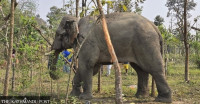Sudurpaschim Province
Poaching of tigers along Karnali bio-corridor worries conservationists
In a recent incident, a big cat died after falling into a trap set up by poachers. Poaching is on the rise in the areas where wild animals are meant to be protected, officials say.
Arjun Shah
An adult tigress was found dead at Amarawati Community Forest in Janaki Rural Municipality-9 on Sunday. Forest officials suspect the tigress died at the hands of poachers who had laid traps in the bio-corridor.
The poaching of a tigress inside the bio-corridor has worried forest officials and conservationists about the rise in poaching activities in areas where wildlife are meant to be protected.
Forest officials said the big cat died after it fell into a trap made up of iron wires set up by poachers.
The community forest where the tigress was found dead with multiple injuries is south of Dudejhari forest in the Lamki area and is around a kilometre west of the Karnali River. The incident site is just 20 metres away from a road leading to Katase Bazaar.
According to conservationists and the locals, the Amarawati forest area is part of the Karnali bio-corridor through which tigers and other wild animals pass. This traditional bio-corridor adjoins the Basanta bio-corridor.
According to conservationists, wild animals, mainly the tigers, from Dudhwa National Park of India, Basanta Protected Area, Mohana Laljhadi forest and Bardiya National Park move through the bio-corridor where the striped tigress was found dead.
“The poaching of the endangered species in the bio-corridor is quite serious. The poachers set a trap along the Karnali bio-corridor inside the protected area,” said Ram Bichari Thakur, chief at Pahalmanpur Division Forest Office in Kailali. “Efforts are on to identify the poachers and bring them to book.” According to him, the tigress might have fallen into the trap two or three days before it was found dead.
A team from the Bardiya National Park conducted the post-mortem of the tigress. The slain tigress was more than 100 kg and its body length was five feet. “It is not clear from where the tigress came to the Amarawati forest area,” said Ram Bahadur Rawal, a forester at the forest office.
According to Rawal, who reached the incident site for investigation, it was apparent that the tigress struggled to free itself from the wire trap around its neck. “The tigress seems to have jumped up to five feet and crawled for around 50 metres to free itself. She sustained serious injuries while trying to break the wire,” said Rawal. “She managed to free herself from the trap but got caught in the barbed wires used to fence the forest area of the Amarawati Community Forest.”
There are Amarawati, Katase, Baklawa and Pal Bazaar settlements within a kilometre from where the tigress was found dead. According to the local people, there had been recent sightings of a tiger in the Janakalyan and Aishwarya community forests.
Bhim Bahadur Rawal, secretary of Amarawati Community Forest Users’ Group, suspects that the tigress fell into the trap in Hariyali Community Forest across the road and came to the Amarawati forest area. “The tigress might have been trapped in a snare installed to hunt other animals,” said Bhim Bahadur.
Poaching of tigers and other wild animals is going unchecked in the bio-corridor areas of Kailali, a Tarai district in Sudurpaschim Province. A striped tiger was killed in the district in March 2021. The tiger was last seen in Salghari of Mohanyal Rural Municipality. Police investigation revealed that the tiger had been killed by poachers.
In July 2021, police arrested Purna Bahadur Budha Magar of Mohanyal Rural Municipality-5 and Lokesh Sijapati of Lamkichuwa Municipality-1 in possession of a tiger’s hide.
The striped tiger or Royal Bengal tiger is an endangered species. According to the National Park and Wildlife Conservation Act 1973, one will be jailed for up to 15 years and fined up to Rs 200,000 if convicted on a tiger poaching charge.
According to the latest tiger census held in 2021, the tiger population in Nepal has reached 355, with the country nearly tripling the number in 12 years. In 2010, there were 121 tigers in Nepal. The number had risen to 198 in 2013 and 235 in 2018.




 10.12°C Kathmandu
10.12°C Kathmandu











